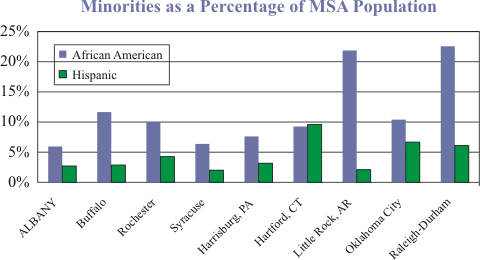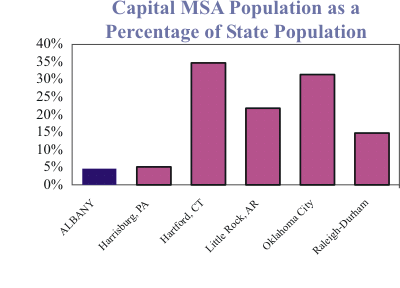 Return to CDRPC
Home Page
Return to CDRPC
Home Page As a part of recent State funding to establish a comprehensive regional database, the Capital District Regional Planning Commission (CDRPC) is creating a set of indicators to measure Regional performance in a broad range of subjects. The indicators measure the success and vitality of the Capital District using both timeline measurements as well as comparisons to similar regions around New York State and the Country.
This set of regional indicators cover a wide range of categories that are of public interest and concern. They are designed to establish a baseline for continuing efforts to improve the Region. The baselines will allow citizens and community leaders to make decisions and set priorities based on objective information about the Capital District’s strengths and weaknesses.
This set of indicators will be used as a basis for a regional dialogue to set goals and objectives for the Capital District’s future. Through that dialogue, the list of indicators will be honed to meet the community’s needs then objectives and strategies will be set for each indicator.
The indicators track items in seven categories including Health, the Environment, Education, Economics, Community Life, Public Safety, and Transportation. The strength of this comprehensive approach is its broad range of topics and the interrelationships among them.
Due to differences in the available information about each topic, it is impossible to set the same timeline or comparison scale for all of the indicators. As a result, there are variations in the criteria used to judge each indicator. Some indicators are best measured by showing progress over time or comparison to government standards while others are best measured by comparison to state or national averages.
CDRPC is attempting to focus the indicators on the Capital District, which covers Albany, Rensselaer, Saratoga, and Schenectady Counties. Due to variation in the available data, that is not always possible. To provide consistent data, comparisons between the Capital District and other regions generally utilize data for each region’s Metropolitan Statistical Area (MSA). The New York Capital District’s Metropolitan Statistical Area is a six county region, adding Montgomery and Schoharie Counties to the Capital District.
CDRPC has assembled a peer group of metropolitan areas for comparison with New York’s Capital Region. In selecting the peer regions for the Capital District, CDRPC searched for similar state capitals and included the other major Upstate New York metro areas. The other capital regions would be expected to have similarly strong government employment while the other upstate metro areas share similar historical, demographic, geographic, and regulatory characteristics. A description of the selection process for the peer capital regions is listed below.
The MSA must:
While the peer regions have many similarities, no two regions are the same. Other than the obvious geographic distinctions, there are significant statistical differences in the regions’ characteristics that should be noted when analyzing the Regional Indicators.

The peer regions range in size from the Little Rock MSA with a population of 583,845, to the Raleigh-Durham MSA’s 1,187,941 residents. The Albany MSA has a population of 875,583. Five of the peer regions have populations greater than 1 million while four, including the Capital District, have fewer.
The Albany MSA has the lowest percentage of African Americans and the third lowest percentage of Hispanics of the peer regions. Little Rock and Raleigh-Durham have by far the highest percentage of African-Americans, while Hartford has the largest Hispanic population.

Economically, The Capital District has the largest number of government employees of the peer regions. This is in no small part due to the size of New York State and the comparably small size of the Capital District. The Albany MSA makes up 4.6% of New York State’s population while most of the other peer capital regions have between 15% and 35% of their state’s population. The lone exception is Harrisburg, PA, which has 5.1% of Pennsylvania’s population. A capital MSA that is small compared to the state’s population is more likely to have state government dominate the region’s economy while a capital MSA with a large percentage of the state’s population would tend to have a more diverse economy.

Capital District Regional Indicators Report: 2003 is available for $25 + $5 Shipping from CDRPC. For information on ordering copies of the Indicator Report, see CDRPC Publications.
Capital District Regional Indicators Report Now Available as PDF File(s)
 Return to CDRPC
Home Page
Return to CDRPC
Home Page